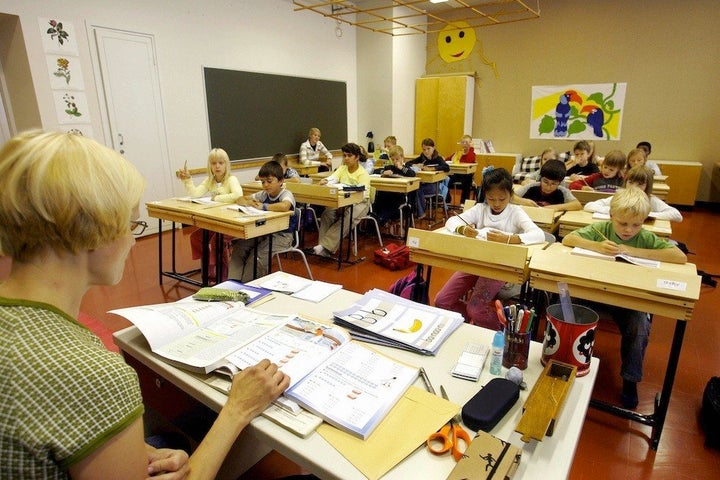
Finland is the mecca of education reformers across the globe. Just before we all gorged on our turkeys and stuffing, Michael Mulgrew, head of the United Federation of Teachers, turned down an invitation for a free, but politically imprudent, pilgrimage from Manhattan Media CEO and mayoral hopeful Tom Allon. Diane Ravitch, of course, had already been there and done that, waxing poetic on the virtues of Finnish education, earlier this fall, in her Education Week blog, "Bridging Differences," with Deborah Meier. Since 2001, when the PISA (Program for International Student Assessments) results went public, this Nordic nation's 15-year-olds have ranked at or near the top of all industrialized nations in reading, science, and mathematics. And we haven't yet stopped talking about it.
Why Finland? Everyone's been in the business of deconstruction, including the Finns, who originally expressed some puzzlement about the ingredients of their success, and then in the spirit of 21st century innovation, launched a web site to meet the world's demand for answers. Here are a few to chew on. First, teachers are highly qualified. Second, they have tremendous autonomy. Third, the teaching profession commands respect, with only one in ten aspiring educators snagging a coveted spot in what are generally regarded as rigorous teacher preparation programs. Next, when teachers do meet their students, in formal school, they're older than most of their primary peers in industrialized countries, and little emphasis on grades is the norm in the early years of schooling. Finally, standardized tests don't make an appearance until very late in the game.
But, wait, there's more.
Recently, I listened and watched, as Judith Wagner, a preschool director and professor of child development at California's Whittier College, did a nifty bit of cultural exporting at "Nordic Perspectives on Caring and Teaching in Early Childhood," a symposium convened by the American-Scandinavian Foundation and the Child Development Institute of Sarah Lawrence. What if I told you that preschoolers have been known to cast a rod into the water, in their birthday suits. That four-year-olds climb trees -- sometimes with eyes closed -- out of the sight of adults. That toddlers eat with knives and forks. Or that preschools are filled with art, and spaces, known as pillow rooms, to which little ones may retreat, alone, for some quiet time.
Shocking, isn't it? And nearly impossible to imagine in our homeland, where three-year-olds ride their scooters encased in armor, where climbers -- not of the arboreal variety -- are made of plastic and grounded in rubber, where a law suit is always a motion away, where parents of college students, not to mention preschoolers, hover, like helicopters, over their progeny, and where teachers, partners in anxiety, hardly dare to leave a child unsupervised, lest some horrific calamity ensue.
The Finns share with their fellow Nordic people a strong commitment to children and a childhood based on egalitarianism, freedom, compromise, and democracy -- the bedrock of the Scandinavian ethos. Reverence for childhood, as a discrete period of development, not as a mere prelude to adulthood, runs deep. Respect for children's views and thinking is paramount. Early childhood, especially, is seen as a time for play and exploration, a vision enshrined in policy as well. Here's a tidbit, courtesy of Pentti Hakkarainen, of the University of Oulu, from the National Curriculum Guidelines on Early Childhood Education and Care in Finland:
Children play for the sake of playing, and at best, play can give them deep satisfaction. Although children do not play in order to learn, they learn through play....Children use everything they see, hear, and experience as elements in their play. When they play, they imitate and create new things...
In early childhood, certain kinds of free play are linked to high creativity. A white paper from the Alliance for Childhood, an advocacy group based in Maryland, highlights the research of Kyung Hee Kim, who analyzed nearly 300,000 scores, of children and adults, on the Torrance creativity test, known as a predictor of future innovation among students. Creativity scores in the United States, Kim told Newsweek, in 2010, had been declining since 1990, with the dip most "serious" from kindergartners through sixth-graders. An ill omen for a society dead set on fostering innovation.
As the U.S. adopts its own national Common Core Standards, with their lack of attunement to young children's unique developmental needs, a look at the Land of the Midnight Sun might prove enlightening. A few years ago, the Danes witnessed a slippage of their 4th graders' PISA math scores. Ever communal and democratic, a group of stakeholders in one of the nation's school districts called a meeting to discuss strategy. The consensus: let the children play more. Wouldn't you know that the scores went up?
